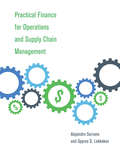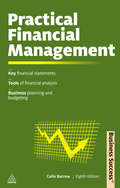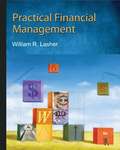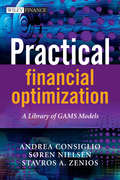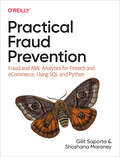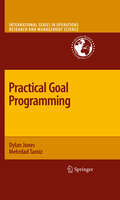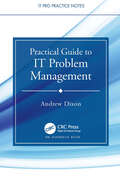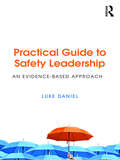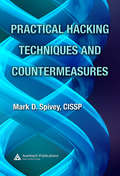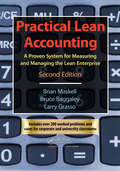- Table View
- List View
Practical Fairness: Achieving Fair And Secure Data Models
by Aileen NielsenFairness is an increasingly important topic as machine learning and AI more generally take over the world. While this is an active area of research, many realistic best practices are emerging at all steps along the data pipeline, from data selection and preprocessing to blackbox model audits. This book will guide you through the technical, legal, and ethical aspects of making your code fair and secure while highlighting cutting edge academic research and ongoing legal developments related to fairness and algorithms.There is mounting evidence that the widespread deployment of machine learning and artificial intelligence in business and government is reproducing the same biases we are trying to fight in the real world. For this reason, fairness is an increasingly important consideration for the data scientist. Yet discussions of what fairness means in terms of actual code are few and far between. This code will show you how to code fairly as well as cover basic concerns related to data security and privacy from a fairness perspective.
Practical Finance for Operations and Supply Chain Management
by Alejandro Serrano Spyros D. LekkakosAn introduction to financial tools and concepts from an operations perspective, addressing finance/operations trade-offs and explaining financial accounting, working capital, investment analysis, and more.Students and practitioners in engineering and related areas often lack the basic understanding of financial tools and concepts necessary for a career in operations or supply chain management. This book offers an introduction to finance fundamentals from an operations perspective, enabling operations and supply chain professionals to develop the skills necessary for interacting with finance people at a practical level and for making sound decisions when confronted by tradeoffs between operations and finance. Readers will learn about the essentials of financial statements, valuation tools, and managerial accounting.The book first discusses financial accounting, explaining how to create and interpret balance sheets, income statements, and cash flow statements, and introduces the idea of operating working capital—a key concept developed in subsequent chapters. The book then covers financial forecasting, addressing such topics as sustainable growth and the liquidity/profitability tradeoff; concepts in managerial accounting, including variable versus fixed costs, direct versus indirect costs, and contribution margin; tools for investment analysis, including net present value and internal rate of return; creation of value through operating working capital, inventory management, payables, receivables, and cash; and such strategic and tactical tradeoffs as offshoring versus local and centralizing versus decentralizing. The book can be used in undergraduate and graduate courses and as a reference for professionals. No previous knowledge of finance or accounting is required.
Practical Finance for Property Investment
by Craig FurfinePractical Finance for Property Investment provides readers with an introduction to the most fundamental concepts, principles, analytical methods, and tools useful for making investing and financing decisions regarding income-producing property. The book begins by considering how to value income-producing property by forecasting a property’s cash flows and estimating appropriate discount rates. It then discusses how both debt and private equity are used as methods to finance a property’s acquisition. The book provides a thorough discussion of the taxation of property income as well as how investors can quantify the risks to investing in property. The book concludes with important considerations for investors when their investment thesis does not come to fruition. Practical Finance for Property Investment offers a unique and novel pedagogy by pairing each book chapter with an in-depth real-world case study, which forces readers to confront the occasional tensions between finance theory and property investment practice. The book is designed for investors and students interested in learning what finance theory implies about property investment. Readers and Instructors can access electronic resources, including the spreadsheets used in the textbook, at the book's website: www.routledge.com/9780367333041.
Practical Financial Management
by Colin BarrowEntrepreneurs need to be financially literate. The most common cause of business failure is poor financial control stemming from an ignorance of the basics of business finance. Practical Financial Management is intended to help those who find business finance confusing. Now in its eighth edition, it continues to provide advice on proper financial planning and control, and reinforces essential points through the use of questions within each section. Beginning with an introduction to the key financial statements, it moves on to look at the tools of financial analysis - the keys to controlling a business successfully. The final part of the book deals with business planning and budgeting, a vital area of business finance as most new ventures cannot get off the ground without a business plan, and existing businesses cannot expand. Now with more examples and explanations of key terms, as well as information on loans for small businesses and guidance on how to analyze business accounts, Practical Financial Management is an invaluable read for aspiring entrepreneurs and those already in business. This book could mean the difference between success and failure.
Practical Financial Management
by William R. LasherThe author William R. Lasher captivates readers with unique insights into the issues and challenges facing financial managers every day. rom a look at hidden agendas and the biases of decision makers in the firm to the analyses of financial proposals, Lasher's practical, relevant presentation keep students reading. This edition examines the latest financial developments, including the financial crisis of 2008-2009. You will find an engaging, complete presentation perfectly matched to the needs of today's business students, from the use of everyday math, rather than advanced math in theory sections, to numerous worked-out examples and graphical and intuitive presentations.
Practical Financial Optimization
by Stavros A. Zenios Andrea Consiglio Soren S NielsonIn Practical Financial Optimization: A Library of GAMS Models, the authors provide a diverse set of models for portfolio optimization, based on the General Algebraic Modelling System. 'GAMS' consists of a language which allows a high-level, algebraic representation of mathematical models and a set of solvers - numerical algorithms - to solve them. The system was developed in response to the need for powerful and flexible front-end tools to manage large, real-life models.The work begins with an overview of the structure of the GAMS language, and discusses issues relating to the management of data in GAMS models. The authors provide models for mean-variance portfolio optimization which address the question of trading off the portfolio expected return against its risk. Fixed income portfolio optimization models perform standard calculations and allow the user to bootstrap a yield curve from bond prices. Dedication models allow for standard portfolio dedication with borrowing and re-investment decisions, and are extended to deal with maximisation of horizon return and to incorporate various practical considerations on the portfolio tradeability. Immunization models provide for the factor immunization of portfolios of treasury and corporate bonds.The scenario-based portfolio optimization problem is addressed with mean absolute deviation models, tracking models, regret models, conditional VaR models, expected utility maximization models and put/call efficient frontier models. The authors employ stochastic programming for dynamic portfolio optimization, developing stochastic dedication models as stochastic extensions of the fixed income models discussed in chapter 4. Two-stage and multi-stage stochastic programs extend the scenario models analysed in Chapter 5 to allow dynamic rebalancing of portfolios as time evolves and new information becomes known. Models for structuring index funds and hedging interest rate risk on international portfolios are also provided.The final chapter provides a set of 'case studies': models for large-scale applications of portfolio optimization, which can be used as the basis for the development of business support systems to suit any special requirements, including models for the management of participating insurance policies and personal asset allocation.The title will be a valuable guide for quantitative developers and analysts, portfolio and asset managers, investment strategists and advanced students of finance.
Practical Fraud Prevention: Fraud and AML Analytics for Fintech and eCommerce, Using SQL and Python
by Gilit Saporta Shoshana MaraneyOver the past two decades, the booming ecommerce and fintech industries have become a breeding ground for fraud. Organizations that conduct business online are constantly engaged in a cat-and-mouse game with these invaders. In this practical book, Gilit Saporta and Shoshana Maraney draw on their fraud-fighting experience to provide best practices, methodologies, and tools to help you detect and prevent fraud and other malicious activities.Data scientists, data analysts, and fraud analysts will learn how to identify and quickly respond to attacks. You'll get a comprehensive view of typical incursions as well as recommended detection methods. Online fraud is constantly evolving. This book helps experienced researchers safely guide and protect their organizations in this ever-changing fraud landscape.With this book, you will:Examine current fraud attacks and learn how to mitigate themFind the right balance between preventing fraud and providing a smooth customer experienceShare insights across multiple business areas, including ecommerce, banking, cryptocurrency, anti-money laundering, and ad techEvaluate potential risks for a new vertical, market, or productTrain and mentor teams by boosting collaboration and kickstarting brainstorming sessionsGet a framework of fraud methods, fraud-fighting analytics, and data science methodologies
Practical Genius: A 5-Step Plan to Turn Your Talent and Passion into Success (Identify, Express, Surround, Sustain, Market Your Genius)
by Gina Amaro RudanWHAT’S YOUR GENIUS? Most people consider genius to be a gift, a “lightning bolt from the gods” that strikes people like Einstein or Mozart, but not the rest of us. They see it as a quality—like creativity—that has a magical, exclusive, elusive connotation. That is simply not true, says Gina Rudan. Every one of us has a capacity for genius. Anyone is capable of achieving something so extraordinary that it could change the game for you, your business, and every aspect of your life. In Practical Genius, Rudan shows you how to: • Identify your genius • Express it in everyday life • Surround yourself with genius • Sustain genius for a lifetime of personal and professional satisfaction • Market your genius to others Each stage features exercises to guide you along the way, leaving you feeling accomplished and ready for the next stage. The outcome is a profound revelation: You have the tools and ability to realize greatness both in and out of the workplace. UNLEASH YOUR GENIUS Forget what you think you know about genius. It’s not about having a Mensa I.Q. or painting the Sistine Chapel. Everyone’s got genius, but it’s up to you to find it, put it to work, and watch it change your life. With the help of Practical Genius, you will: Identify your genius. Where do your passions and your talents meet? (page 23) Express your genius. What’s your story, and how do you share it with others? (page 57) Surround yourself with genius. Who do you need in your tribe? (page 93) Sustain your genius. How do you feed and care for your genius? (page 135) Market your genius. Why are your contradictions actually your largest competitive advantage? (page 165)
Practical Goal Programming
by Mehrdad Tamiz Dylan JonesPractical Goal Programming is intended to allow academics and practitioners to be able to build effective goal programming models, to detail the current state of the art, and to lay the foundation for its future development and continued application to new and varied fields. Suitable as both a text and reference, its nine chapters first provide a brief history, fundamental definitions, and underlying philosophies, and then detail the goal programming variants and define them algebraically. Chapter 3 details the step-by-step formulation of the basic goal programming model, and Chapter 4 explores more advanced modeling issues and highlights some recently proposed extensions. Chapter 5 then details the solution methodologies of goal programming, concentrating on computerized solution by the Excel Solver and LINGO packages for each of the three main variants, and includes a discussion of the viability of the use of specialized goal programming packages. Chapter 6 discusses the linkages between Pareto Efficiency and goal programming. Chapters 3 to 6 are supported by a set of ten exercises, and an Excel spreadsheet giving the basic solution of each example is available at an accompanying website. Chapter 7 details the current state of the art in terms of the integration of goal programming with other techniques, and the text concludes with two case studies which were chosen to demonstrate the application of goal programming in practice and to illustrate the principles developed in Chapters 1 to 7. Chapter 8 details an application in healthcare, and Chapter 9 describes applications in portfolio selection.
Practical Government Budgeting: A Workbook For Public Managers (Suny Series In Public Administration Ser.)
by Susan L. Riley Peter W. ColbyThis book provides descriptions, instructions, and exercises to help readers master government budgeting as it is actually practiced. University courses and training programs serving present and future state and local officials and staff will learn how to do public budgeting in this relevant, practical, and useful workbook. Each chapter presents techniques followed by step-by-step instructions complete with examples to help students learn the material. Self-test exercises conclude each chapter.
Practical Graph Mining with R (Chapman & Hall/CRC Data Mining and Knowledge Discovery Series)
by John Jenkins Nagiza F. Samatova Arpan Chakraborty William Hendrix Kanchana PadmanabhanDiscover Novel and Insightful Knowledge from Data Represented as a GraphPractical Graph Mining with R presents a "do-it-yourself" approach to extracting interesting patterns from graph data. It covers many basic and advanced techniques for the identification of anomalous or frequently recurring patterns in a graph, the discovery of groups or cluste
Practical Guide for Waiters Second edition revised and expanded
by Franklin A. Díaz Lárez Louise JennewineThis is a great guidebook for anyone who wants to become a waiter, or for waiters who aspire to move up in the industry. Covers basic aspects of table service, the types of service offered in fine dining venues, best practices for formal dining occasions, and much more. There is an additional section that covers the basics of bartending and mixed drinks. The author has many years of experience as a waiter in the hotel and restaurant industry.
Practical Guide to IT Problem Management (IT Pro Practice Notes)
by Andrew DixonSome IT organisations seem to expend all their energy firefighting – dealing with incidents as they arise and fixing, or patching over, the breakage. In organisations like this, restarting computers is seen as a standard method to resolve many issues. Perhaps the best way to identify whether an organisation understands problem management is to ask what they do after they have restarted the computer. If restarting the computer fixes the issue, it is very tempting to say that the incident is over and the job is done. Problem management recognises that things do not improve if such an approach is taken. Such organisations are essentially spending their time running to stay in the same place. Written to help IT organisations move forward, Practical Guide to IT Problem Management presents a combination of methodologies including understanding timelines and failure modes, drill down, 5 whys and divide and conquer. The book also presents an exploration of complexity theory and how automation can assist in the desire to shift left both the complexity of the problem and who can resolve it. The book emphasises that establishing the root cause of a problem is not the end of the process as the resolution options need to be evaluated and then prioritised alongside other improvements. It also explores the role of problem boards and checklists as well as the relationship between problem management and Lean thinking. This practical guide provides both a framework for tackling problems and a toolbox from which to select the right methodology once the type of problem being faced has been identified. In addition to reactive methods, it presents proactive activities designed to reduce the incidence of problems or to reduce their impact and complexity should they arise. Solving problems is often a combination of common sense and methodologies which may either be learnt the hard way or may be taught. This practical guide shows how to use problem solving tools and to understand how and when to apply them while upskilling IT staff and improving IT problem solving processes.
Practical Guide to Safety Leadership: An Evidence-Based Approach
by Luke DanielLeaders can shape an organisation through their behaviours and their vision. If an organisation lacks a clear vision or there is disengagement by the leadership team, then the results can be disastrous. In such circumstances change is needed. When change is needed, the value of safety can become a change agent. From the disciplines of leadership and safety comes the emerging topic of safety leadership. Through safety leadership, workplace challenges can be rectified and the desired behaviours reinforced. These challenges can span from a lack of leadership engagement, poor safety performance, complacency or lack of safety ownership. Understanding how safety leadership differs from other leadership theories can give you a competitive edge which is not solely based upon financial quotas, but instead based upon the moral code of ensuring the health and well-being of your employees. This book goes beyond mere safety slogans or anecdotal stories that relate to safety leadership. Instead an empirical and research-based approach will be shared which can help improve the overall culture of an organisation as well as the safety of employees. Tools, case studies, theories and practical applications will be shared which can help create the blueprint for organisational change that you seek. Even when things are working well, constant innovation and adoption of best practices can help companies go from good to great and leave a lasting legacy for employees and customers alike. Detailing the mechanics of safety leadership, this book will drive the change and results you want.
Practical Hacking Techniques and Countermeasures
by Mark D. SpiveyPractical Hacking Techniques and Countermeasures examines computer security from the hacker's perspective, demonstrating how a security system can be designed and structured to repel an attack. This book shows how an attack is conceptualized, formulated and performed. With the VMware Workstation software package available on the accompanying CD, it uses virtual computers to illustrate how an attack is executed, including the script, compilation, and results. It offers examples of attacks on Windows and Linux. It also covers such topics as footprinting, scanning, sniffing, passwords, and other attack tools. This text provides valuable information for constructing a system to defend against attacks.
Practical Handbook Business in Africa
by Thomas Schmidt Kay Pfaffenberger Stefan LiebingAfrica is a continent on the upswing, developing great economic momentum. If German companies want to participate in Africa's upswing, they need to be familiar with some special features. This book shows the way to successful business in Africa. It is a practical, yet scientifically based guide for all entrepreneurs and economically interested parties who want to be successful in Africa. It combines the experience of many companies with the scientific perspective and findings of the Centre for Business and Technology in Africa at Flensburg University of Applied Sciences.In the 2nd edition new developments on the African continent are taken up and current answers are given to the classical questions, which each actor must answer for itself, which wants to be economically successful in Africa: WHY Africa is interesting for the business, WHERE the largest chances of success exist, HOW to proceed and WHICH approaches for the future organization of the economic relations between Germany and Africa are promising.The book describes how to invest in Africa and bundles the current experiences of managers of large corporations and family businesses with a long history on the continent.
Practical Healthcare Epidemiology
by Ebbing Lautenbach Keith F. Woeltje Preeti N. MalaniIn recent years, issues of infection prevention and control, patient safety, and quality-of-care have become increasingly prominent in healthcare facilities. Practical Healthcare Epidemiology takes a practical, hands-on approach to these issues, addressing all aspects of infection surveillance and prevention in clear, straightforward terms. This fully revised third edition brings together the expertise of more than fifty leaders in healthcare epidemiology who provide clear, sound guidance on infection prevention and control for the full range of patients in all types of healthcare facilities, including those in settings with limited resources. A powerful resource for practitioners in any branch of medicine or public health who are involved in infection prevention and control, whether they are experienced in healthcare epidemiology or new to the field. "A handy desk reference and an up-to-date primer for trainees and experts alike" --The Journal of the American Medical Association "An essential for anyone in the field. "--Thomas R. Talbot, Chief Hospital Epidemiologist, Vanderbilt University Medical Center
Practical Healthcare Epidemiology (3rd edition)
by Ebbing Lautenbach Keith Woeltje Preeti MalaniIn recent years, issues of infection prevention and control, patient safety, and quality-of-care have become increasingly prominent in healthcare facilities. Practical Healthcare Epidemiology takes a practical, hands-on approach to these issues, addressing all aspects of infection surveillance and prevention in clear, straightforward terms. This fully revised third edition brings together the expertise of more than fifty leaders in healthcare epidemiology who provide clear, sound guidance on infection prevention and control for the full range of patients in all types of healthcare facilities, including those in settings with limited resources. A powerful resource for practitioners in any branch of medicine or public health who are involved in infection prevention and control, whether they are experienced in healthcare epidemiology or new to the field. "A handy desk reference and an up-to-date primer for trainees and experts alike" --The Journal of the American Medical Association "An essential for anyone in the field. "--Thomas R. Talbot, Chief Hospital Epidemiologist, Vanderbilt University Medical Center
Practical Healthcare Epidemiology (4th Edition)
by Ebbing Lautenbach Keith F. Woeltje Preeti N. MalaniPractical Healthcare Epidemiology takes a hands-on approach to infection prevention for physicians, healthcare epidemiologists, infection preventionists, microbiologists, nurses, and other healthcare professionals.<P><P> Increased regulatory requirements and patient knowledge and involvement has elevated patient safety, healthcare-associated infections, antibiotic stewardship and quality-of-care to healthcare wide issues. <P>This fully updated new edition brings together the expertise of leaders in healthcare epidemiology to provide best practice expert guidance on infection prevention for adult and pediatric patients in all types of healthcare facilities, from community hospitals and academic institutions, to long-term care and resource limited settings. Written in clear, straightforward terms to address prevention planning and immediate responses to specific situations, this is the go-to resource for any practitioners in medicine or public health involved in infection prevention, regardless of their current expertise in the field.<P> In light of headline grabbing outbreaks like Ebola, the important subject of infection prevention and control in healthcare settings is more topical than ever.<P> The chapters of this book are clear and succinct, making excellent use of charts, graphs, and bulleted lists to guide the reader to essential information.<P> Provides a resource both for those new to the field and foundation of best practices across the healthcare continuum for specialists.
Practical IT Service Management
by Thejendra BSThis book shows you how to set up a technical service management structure, using the best practice framework established by the IT Infrastructure Library. The ITIL system is the most widely accepted approach to technical IT service management worldwide. It teaches technical support staff how to provide the efficient IT services that are vital to your company's success.
Practical Innovation in Government: How Front-Line Leaders Are Transforming Public-Sector Organizations
by Dean M. Schroeder Alan G RobinsonThis book is a comprehensive guide to an exciting new approach that managers at any level can use to transform their corners of government.Whether people want more government or less, everyone wants an efficient government. Traditional thinking is that this requires a government to be run more like a business. But a government is not a business, and this approach merely replaces old problems with new ones.In their six-year, five-country study of seventy-seven government organizations-ranging from small departments to entire states-Alan Robinson and Dean Schroeder found that the predominant private-sector approaches to improvement don't work well in the public sector, while practices that are rare in the private sector prove highly effective. The highest performers they studied had attained levels of efficiency that rivaled the best private-sector companies.Rather than management making the improvements, as is the norm in the private sector, these high-performers focused on front-line-driven improvement, where most of the change activity was led by supervisors and low-level managers who unleashed the creativity and ideas of their employees to improve their operations bit by bit every day.You'll discover how Denver's Department of Excise and Licenses reduced wait times from an hour and forty minutes to just seven minutes; how the Washington State Patrol garage tripled its productivity and became a national benchmark; how a K8 school in New Brunswick, Canada, boosted the percentage of students reading at the appropriate age level from 22 percent to 78 percent; and much more.
Practical Lakehouse Architecture: Designing and Implementing Modern Data Platforms at Scale
by Gaurav Ashok ThalpatiThis concise yet comprehensive guide explains how to adopt a data lakehouse architecture to implement modern data platforms. It reviews the design considerations, challenges, and best practices for implementing a lakehouse and provides key insights into the ways that using a lakehouse can impact your data platform, from managing structured and unstructured data and supporting BI and AI/ML use cases to enabling more rigorous data governance and security measures.Practical Lakehouse Architecture shows you how to:Understand key lakehouse concepts and features like transaction support, time travel, and schema evolutionUnderstand the differences between traditional and lakehouse data architecturesDifferentiate between various file formats and table formatsDesign lakehouse architecture layers for storage, compute, metadata management, and data consumptionImplement data governance and data security within the platformEvaluate technologies and decide on the best technology stack to implement the lakehouse for your use caseMake critical design decisions and address practical challenges to build a future-ready data platformStart your lakehouse implementation journey and migrate data from existing systems to the lakehouse
Practical Law Office Management (3rd Edition)
by Brent RoperPractical Law Office Management, third edition focuses on law office management from a practical standpoint. Designed for the paralegal student interested in day-to-day law office management topics, this text focuses on client relations and communication skills; legal fees, timekeeping, and billing, client trust funds and law office accounting; calendaring, docket control, and case management; legal marketing; and file and law library management. This revised edition offers an extended focus on technology, including a full demonstration of Thomson's ProLaw software and in-depth software tutorials. It includes up-to-date charts and graphs that present material in an easy-to-understand context. Each chapter now includes thought-provoking questions, and expanded and interesting case studies that deal with unique facts specific to practicing paralegals appear after most chapters. To expand the technology focus of the text, Excel exercises appear in the timekeeping and billing and trust account chapters. In addition, this revised text has a strong ethics focus throughout, with ethics-related cases included at the end of nearly every chapter.
Practical Leadership Skills for Safety Professionals and Project Engineers
by Gary L. WinnFor Future Leaders in Safety and EngineeringYou've chosen to become a leader in occupational health and safety. Practical Leadership Skills for Safety Professionals and Project Engineers can show you how. Purposely oriented toward the art and science of leadership, this book is designed to provide insight and outline development techniques for the
Practical Lean Accounting: A Proven System for Measuring and Managing the Lean Enterprise, Second Edition
by Brian H. Maskell Bruce Baggaley Larry GrassoThe methods and concepts presented in the bestselling first edition revolutionized the approach to the management and control of Lean companies. Enhanced with extensive end-of-chapter exercises and downloadable resources with Lean accounting tools, the second edition of this preeminent practitioner’s guide is now suitable for classroom use. Practical Lean Accounting: A Proven System for Measuring and Managing the Lean Enterprise, Second Edition explains exactly what it takes to transform a traditional accounting system to one that supports and enhances a company’s Lean efforts. Defining the fundamental principles of Lean accounting, it demonstrates how to use them to identify and eliminate wasteful transactions. The book includes coverage of cell performance measurement, use of the box score, operational and financial planning, cost targeting, Lean accounting diagnostics, and value stream mapping. Retaining the easy-to-use format that made the first edition a bestseller, this updated edition includes: A new section on the use of value stream performance measurements in continuous improvement A re-written Target Costing chapter that emphasizes a value-based approach to the management of the Lean value system A Lean Accounting Diagnostic tool to help you assess progress and develop a plan for implementing changes Cutting-edge examples that illustrate implementation in accounting departments Downloadable resources with data from the ECI Value Stream Cost Analysis case study included in the text, Excel templates, and end-of-chapter questions with solutions The book contains a wealth of tools that makes it ideal for company training sessions and advanced undergraduate and graduate-level courses. For each major example provided, two similar problems are included—one for instructors to guide students through and a second for students to work through on their own. An additional set of problems and questions for testing purposes are also available to instructors on the authors’ website.Unfortunately, during the publishing process mistakes can be made that are not caught before the book is printed. Productivity Press takes great care to catch any errors prior to the printing stage.

